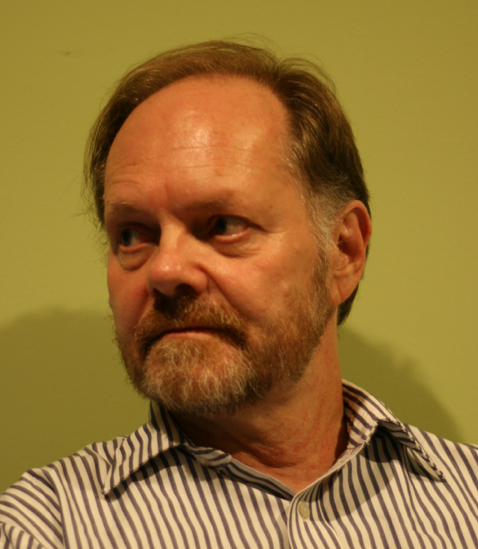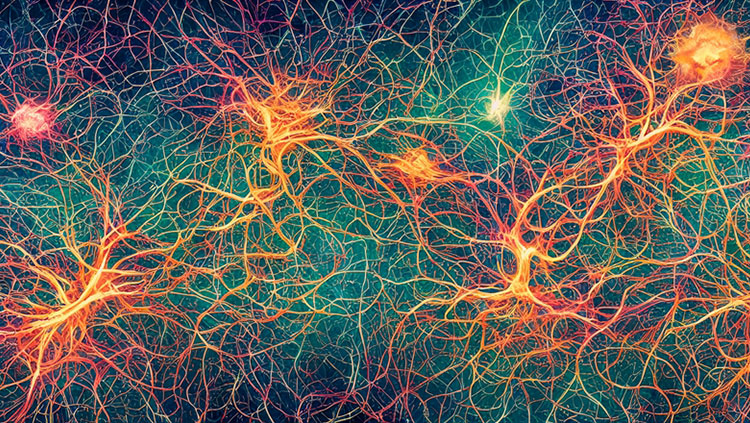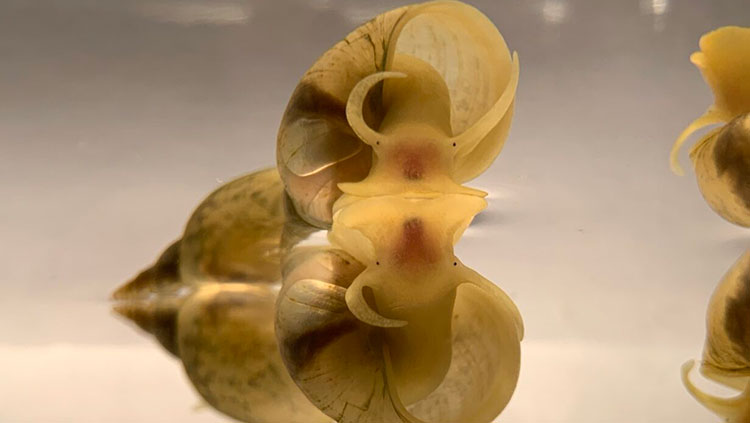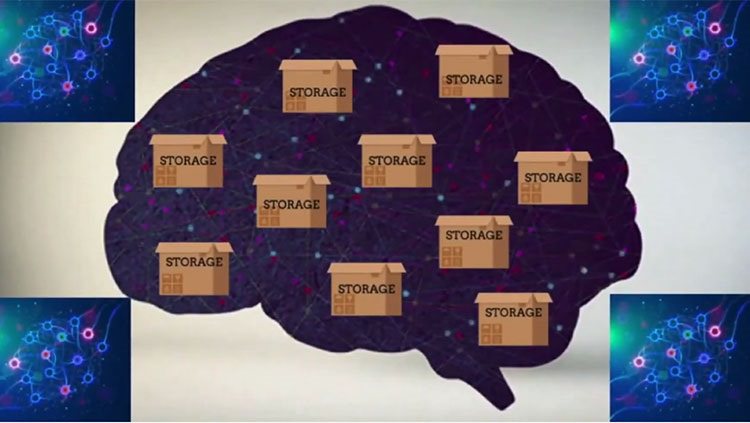Brain Mechanisms of Skill Learning
- Published30 Apr 2015
- Author John Kubie
- Source BrainFacts/SfN
Think of a skill you have, something that took practice, but now feels easy. Perhaps it’s serving in tennis, or a new dance step, or juggling — something I used to be able to do. 
When I was in boarding school my grandmother regularly sent boxes of oranges. The address was wrong, the delivery late and the oranges always arrived spoiled. Not wanting to disappoint my grandmother, I decided to use the oranges to learn to juggle. The learning process was slow. After a week I could juggle a bit, but it required intense concentration. I felt jerky and awkward and there were lots of drops. Over the next month, juggling gradually became smooth and effortless. In the initial stages when my movements were awkward, I had to focus on throwing and catching, left hand and right. At the final stages I felt I didn’t have to think at all. I could carry on a conversation, let my mind wander, and juggling continued. (I was so confident that I felt like I could juggle with my eyes closed; this turn out not to be true). Skill learning is the acquisition of motor patterns. While the learning process requires concentration and repetition, once acquired, skills run smoothly, efficiently, and almost thoughtlessly. A recent paper by Risa Kawai and others working in Bence Olveczky’s lab at Harvard is revealing (Olveckzy lab publications here)1. The study exploits a creative experimental design to dissect the brain mechanisms underlying motor skills. But before describing the Kawai et al study, let's have a brief overview of the motor organization in the brain and spinal cord.

The Motor Brain
- Motor neurons are neurons that innervate muscles. Motor signals must go through the “final common path” of motor neurons to produce behavior. Motor neurons are found in the ventral horn of the spinal cord.2
- Various regions in the CNS produce behavior by influencing motor neurons either directly or indirectly. Most prominent is the “motor cortex” in the frontal lobe. Neurons in the motor cortex project to the vicinity of motor neurons in the spinal cord and brainstem.

- Two subcortical motor centers are the basal ganglia and the cerebellum. The basal ganglia are found deep in each cerebral hemisphere. The cerebellum is attached to the back (dorsal side) of the brainstem. Both of these structures project to motor cortex. Thus, each can influence behavior by influencing motor cortex. In addition both the basal ganglia and cerebellum have output that bypasses the motor cortex, and can influence motor neurons with connections through the brainstem.
- The Brainstem3 contains additional "sub-cortical" motor control structures. These include the superior colliculus, the red nucleus and the reticular formation.
- Low-level motor circuits are also organized in the brainstem and spinal cord. These predominantly have to do with inborn reflexes and fixed patterns.
The study: Motor Cortex Is Required For Learning but Not For Executing a Motor Skill
The method for training a rat to learn a motor skill is elegant. The design is to let each rat choose its own motor pattern and self-train. This is done, not by requiring the rat to perform a specific motor pattern to get a reward, but rather to achieve a specific behavioral endpoint, and the rat can decide how to achieve the endpoint. Specifically, the rat is first water-deprived. To get a drop of water the rat has to press a bar, wait a about 0.7 seconds and press a second time. If presses within a time window around 0.7 seconds between par presses, the rat is rewarded with water. In other words, it is a timing task. For the rat to behave most efficiently, it must devise a means of measuring time.
Like people, rats are not very good at simply estimating short time durations. Instead the rats must figure out an indirect method for time measurement. Each rat in the study learned to perform a specific behavior sequence that lasted for approximately the desired time. With thousands of trials of training, each rat learned to improve its behavior pattern until it achieved the desired goal: measuring 0.7 seconds. If a rat pressed the bar, performed a second behavior pattern that took approximately 0.7 seconds, and pressed a second time, it got a reward. If the behavior took precisely 0.7 seconds, it received rewards with great efficiency4.

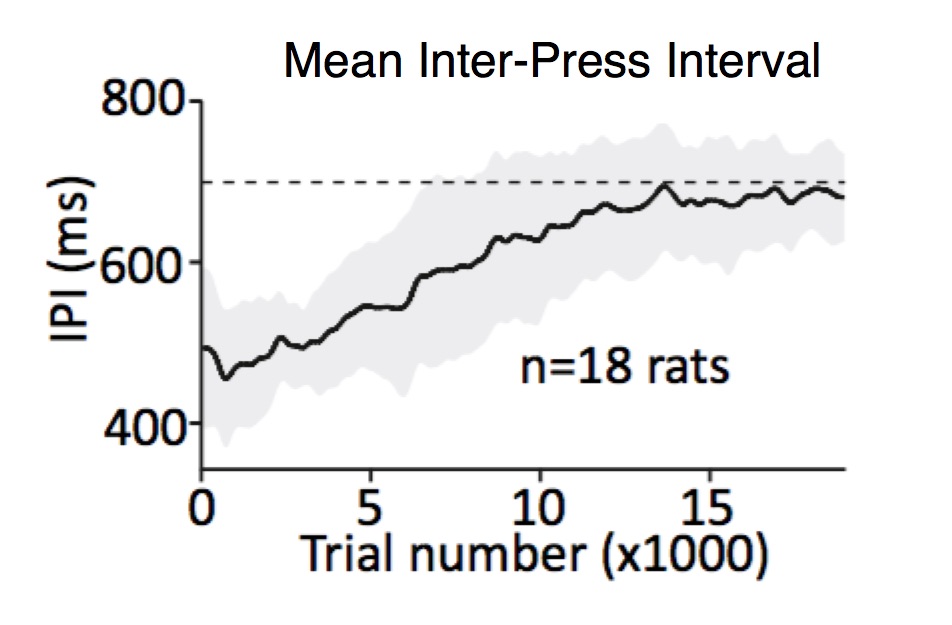
Training on this task is slow, but it occurs. One measure of behavior is called "Inter-press interval" or IPI, the time between bar presses. The optimal IPI is 0.7 seconds ( 700 milliseconds), just long enought to get water reward. The plot to the right illustrates that with training rats increase their IPI and approach optimal levels at 10,000 training trials.
What is fascinating is that, in order to accurately time 0.7 seconds each rat learns to perform a precise motor pattern. The precision of each pattern in movement and time make them clear examples of skill learning. Each rat designed its own skill.
Risa Kawai and colleagues provide videos showing the diversity of precision of the various motor skills. I enourage you to look at the videos available here (Olveczky lab; videos and manuscript at top. I was stunned by the videos. They give extraordinary evidence of the precision in movement and timing of a motor skill.)

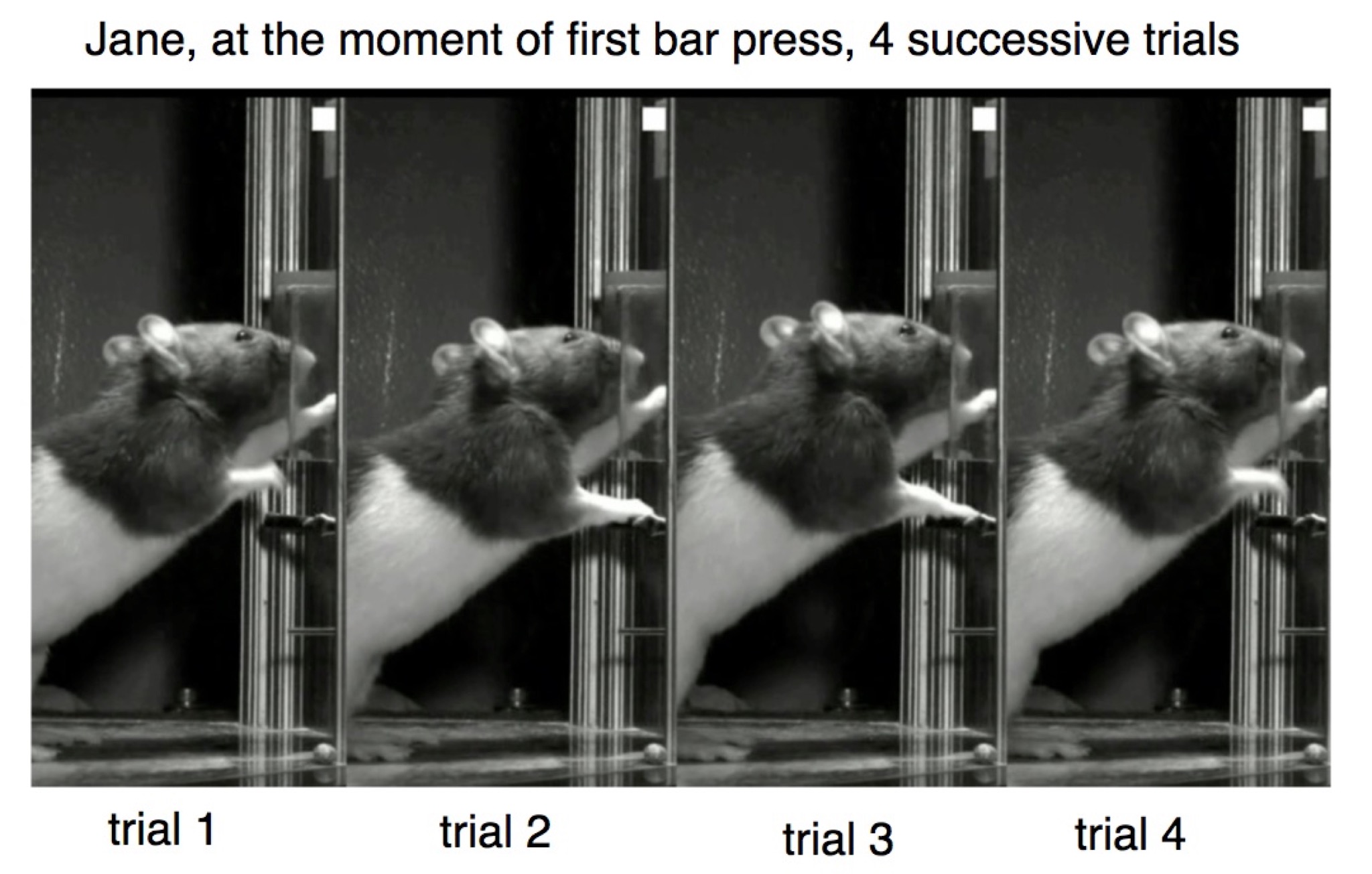
The image above is from the first video. The 4 images appear to be repeats, but they are actually frames from successive trials, illustrating the remarkable regularity of “Jane’s” behavior. When you watch the videos, especially stepping through them frame-by-frame, you will see how precise the timing and behavior of the skilled motor sequence has become after thousands of trials.
It's also interesting to try to get into the rat's head and imagine what the rat thinks it is doing. Is it thinking (although obviously not in a language equivalent) "I have to press the bar, wait a certain period and press again; this motor pattern is a good timing mechanism." Or is it thinking "If I perform this motor pattern correctly, I'll get a reward"? Although it can't be shown, I'm quite certain it is the latter. That the rat thinks the specific behavior is critical and only that behavior pattern will work. This is reminiscent of — but not the same as — superstitious behavior seen in animals and people5 (modified from fig 4b, Kawai et al.)
(modified from fig 4b, Kawai et al.)

What brain areas control skilled movements? Most of us in Neuroscience have a Motor-cortex-centric view of the motor system. That is, neuroscientists commonly feel that motor cortex is king, and that it drives all complex, skilled behavior. The clear prediction resulting from this assumption is that removing the motor cortex ought to destroy or disrupt precise skilled behavior. When Kawai and colleagues made motor cortex lesions, however, that is not what they found. On the contrary, following large lesions of motor cortex, most rats had no change in skilled behavior6.
The image below is derived from a still frame in video 5, which shows that the rat does not need motor cortex to exhibit a learned skilled behavior.

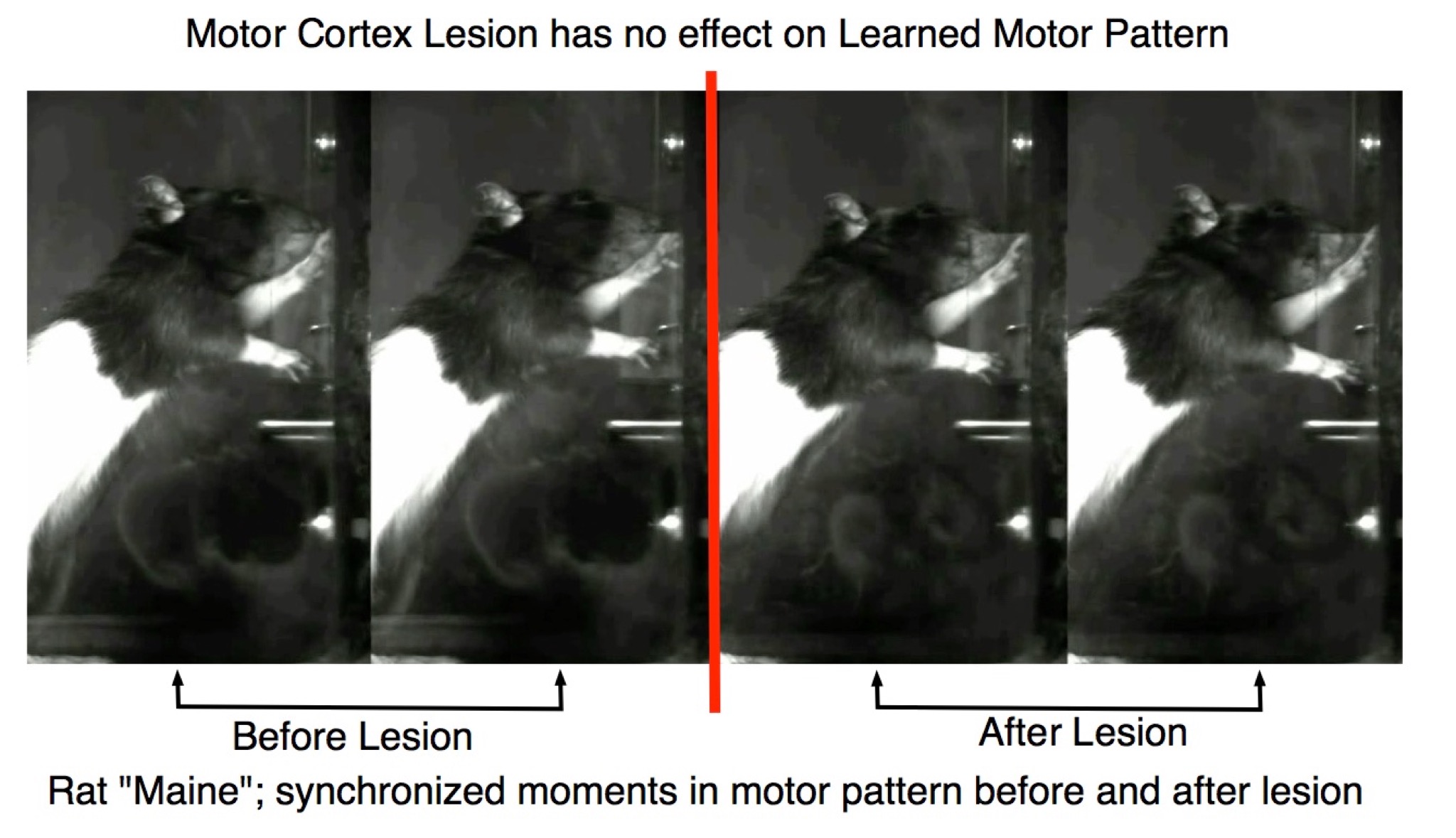
Recall that the motor system is based on motor cortex plus subcortical sites that include the basal ganglia, cerebellum and parts the brainstem. The results of motor cortex lesion show that motor cortex is not essential for a well-learned skilled behavior. One or more of the subcortical sites "store" the learned motor program and control the skilled behavior. That is, this suggests that sub-cortical site(s) are modified in the learning process. The study by Kawai et al did not address the question of which sub-cortical region is critical. My guess is basal ganglia, but this remains an open question.
 (modified from fig 7b, Kawai et al)
(modified from fig 7b, Kawai et al)
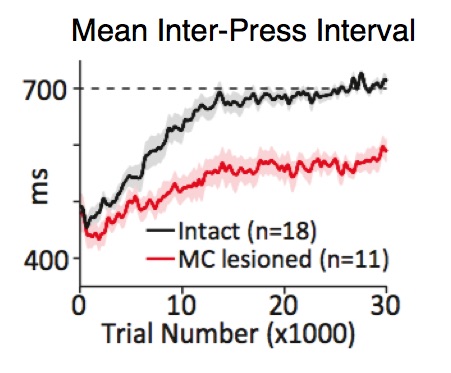
Although motor cortex appears to have no role in executing a skilled motor pattern, it does appear to have a role in learning. The red line at right shows that the animals with motor cortex lesions never create skilled motor patterns that solve the task.

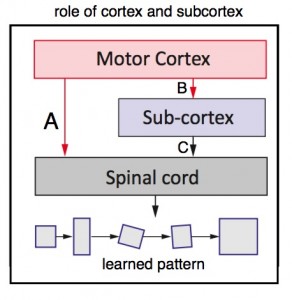
Summary. The figure at right (modified from the paper) summarizes the findings. The boxes at bottom illustrate the learned motor pattern, composed of motor pieces linked together. The linkage, not the pieces represent learning. Arrows A, B and C represent possible learning and retention routes. The finding that rats with lesions of motor cortex retain skilled learning shows that the projection from motor cortex to spinal cord (A) is not critical for exhibiting a well learned motor skill. Clearly, a subcortical structure is involved. On the other hand, this result shows that the connection from sub-cortex to spinal cord (arrow C) is a critical connection for learned skills. Finally, the finding that motor cortex is essential for learning a new motor skill suggests that the projection from motor cortex to sub-cortex (arrow B) is an essential part of the learning process. The authors suggest that the motor cortex "tutors" the sub-cortex during the process of skill learning, but is not essential after the skill is learned.
Questions:
- Which sub-cortical structure or structures are critical?
- If 'tutoring' is correct, what are the neuronal and synaptic mechanisms of tutoring?
- Rats are not humans. How do these findings in rats apply to human motor skills?
CONTENT PROVIDED BY
BrainFacts/SfN
References
Notes:
1 Kawai, R., Markman, T., Poddar, R., Ko, R., Fantana, A. L., Dhawale, A. K., et al. (2015). Motor Cortex Is Required for Learning but Not for Executing a Motor Skill. Neuron, 1–14. http://doi.org/10.1016/j.neuron.2015.03.024 all Olveckzy lab publications and videos
2 There are also 9 small clusters of motor neurons in the brainstem, the cranial nerve motor nuclei.These innervate muscles in the head: facial expression, jaw movement, eye muscles and some neck muscles; they not involved in behaviors described the study.
3 The brainstem, shaped like a fist attached to a forearm, is the core of the brain. It is the brain with cerebral hemispheres and cerebellum shaved off. (Some definitions also shave off the fist-shaped thalamus).
4 Training is a little more complex. Rewarded bar presses must be within a time window centered around 0.7 seconds. As training increases and behavior becomes more precise the window is narrowed.
5 In 1948 BF Skinner described superstitious behavior in pigeons. In the experiment, food was delivered with 5 second intervals between food delivery. Food delivery was unrelated to the bird's behavior. What Skinner found was that birds slowly developed motor patterns that filled the 5-second interval between food deliveries. It is as if the bird exhibited some random behavior, and thought the behavior caused the food to arrive, and repeated the behavior again and again. Have you ever word some item of clothing before a test, gotten a good mark on the test, and, on subsequent tests worn the same clothes? Did you feel the clothes contributed to your good grade? This is not identical to the training in the Kawai paper, but seems closely related.
6 The motor sequence was disrupted in a a few rats who had incorporated digit (finger) movements into the motor pattern. Finger movements are termed "dextrous" movements. It appears that after an animal learns a skilled motor task, motor cortex is only essential if the task requires "dextrous" movements.


